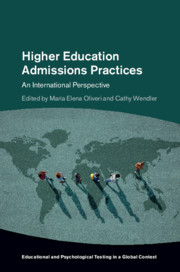Book contents
- Higher Education Admissions Practices
- Educational and Psychological Testing in a Global Context
- Higher Education Admissions Practices
- Copyright page
- Contents
- Figures
- Tables
- Contributors
- Series Editor’s Foreword
- Foreword
- Acknowledgments
- Part I Global Challenges and Common Admissions Models
- Chapter 1 An Overview of Higher Education Admissions Processes
- Chapter 2 Comparing College Aspirations across PISA Countries: Are 17 Percent Oranges Less than 75 Percent Apples?
- Chapter 3 Merit-Based Admissions in Higher Education
- Chapter 4 The Open Admissions Model: An Example from the United States
- Chapter 5 Character-Based Admissions Criteria in the United States and in Europe: Rationale, Evidence, and Some Critical Remarks
- Chapter 6 Cross-Cultural and Global Competencies and Their Role in Admissions Policies and Practices
- Part II Country-Specific Admissions Practices
- Part III Assessments Used in Higher Education Admissions
- Part IV Rethinking Higher Education Admissions
- Index
- References
Chapter 3 - Merit-Based Admissions in Higher Education
from Part I - Global Challenges and Common Admissions Models
Published online by Cambridge University Press: 09 January 2020
- Higher Education Admissions Practices
- Educational and Psychological Testing in a Global Context
- Higher Education Admissions Practices
- Copyright page
- Contents
- Figures
- Tables
- Contributors
- Series Editor’s Foreword
- Foreword
- Acknowledgments
- Part I Global Challenges and Common Admissions Models
- Chapter 1 An Overview of Higher Education Admissions Processes
- Chapter 2 Comparing College Aspirations across PISA Countries: Are 17 Percent Oranges Less than 75 Percent Apples?
- Chapter 3 Merit-Based Admissions in Higher Education
- Chapter 4 The Open Admissions Model: An Example from the United States
- Chapter 5 Character-Based Admissions Criteria in the United States and in Europe: Rationale, Evidence, and Some Critical Remarks
- Chapter 6 Cross-Cultural and Global Competencies and Their Role in Admissions Policies and Practices
- Part II Country-Specific Admissions Practices
- Part III Assessments Used in Higher Education Admissions
- Part IV Rethinking Higher Education Admissions
- Index
- References
Summary
Different principles guide how students are selected when there is competition in college admissions. A merit based approach is most common: If there is competition, the candidate with the best qualifications, or merits, "wins." The way merit is defined and measured is a complicated matter that has to do with validity and views of fairness.Systems where desirable positions are promoted based on merit are sometimes called meritocratic, but this term can be interpreted in both positive and negative sense. This chapter describes and discusses principles for allocation of study places where individuals are promoted or selected on the basis of their merits; challenges of such models; and consequences for individuals, higher education institutions, and society at large.
Keywords
- Type
- Chapter
- Information
- Higher Education Admissions PracticesAn International Perspective, pp. 34 - 50Publisher: Cambridge University PressPrint publication year: 2020
References
- 1
- Cited by



